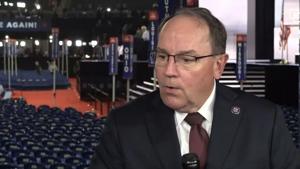'Outrageous': Lawmakers bash Biden admin for targeting, surveilling 156 Republicans








A bipartisan coalition of state officials, including Wisconsin Attorney General Josh Kaul, sued the Department of Agriculture on Tuesday to keep the Supplemental Nutrition Assistance Program partially funded through November.
In a press release obtained by NOTUS ahead of the lawsuit being filed, New York Attorney General Letitia James argued the administration is unlawfully allowing SNAP to run out of funding when it has “access to billions of dollars in contingency funds that Congress specifically appropriated to keep benefits flowing during funding lapses.”
The coalition of state officials, which includes attorneys general and governors, filed the lawsuit in a federal court in Massachusetts. They are asking for a court to immediately intervene to keep funding, which is set to run out at the end of the month, flowing. The program is facing the possibility of its first-ever pause in funding because of the government shutdown.
“Millions of Americans, including children, seniors, and veterans, are on the verge of losing access to the food assistance they rely upon,” Kaul said. “No one should have to go hungry because of dysfunction in our federal government.”
Politico first reported that dozens of Democratic attorneys general and governors were considering legal action. The coalition includes officials from New York, Nevada, Michigan, North Carolina, Pennsylvania and California.
Nevada’s and Vermont’s attorneys general are part of the lawsuit, the only states listed that have Republican governors. In all, more than 24 states and the District of Columbia are involved.
“We are approaching an inflection point for Senate Democrats. Continue to hold out for the Far-Left wing of the party or reopen the government so mothers, babies, and the most vulnerable among us can receive timely WIC and SNAP allotments,” a spokesperson for the Department of Agriculture said in a statement in response to the lawsuit.
In a memo Axios reported last week, the Department of Agriculture took the position that it would not tap into contingency funds and also argued that states that picked up the tab in the meantime could not be legally reimbursed.
The coalition of state officials is asking the court to issue a temporary restraining order mandating USDA to use all of the “available contingency funds toward November SNAP benefits for all plaintiff states.”
It’s one of several steps state officials are trying to take to preserve SNAP benefits, which nearly 42 million people across the country rely on. Outside of legal action, state officials have sought to tap emergency funding in their own states — though some have protested the lack of assurance that the federal government will reimburse their states and have argued that it’s the federal government’s responsibility.
This story was produced and originally published by NOTUS, a publication from the nonprofit, nonpartisan Allbritton Journalism Institute.
Wisconsin joins bipartisan coalition of states suing Trump administration over SNAP is a post from Wisconsin Watch, a non-profit investigative news site covering Wisconsin since 2009. Please consider making a contribution to support our journalism.

Last week, my colleague Joe Timmerman and I published a story about a group of teenagers who run their rural village’s only local newspaper. For over 80 years, as other local news has dwindled, students at Pulaski High School have kept their community informed by publishing the weekly Pulaski News.
“You’ve seen other local papers close and their communities really don’t have anything,” said Bob Van Enkenvoort, the school district’s communications coordinator and the paper’s editor. “So the district sees this as a valuable community service.”
It’s the (unfortunately rare) kind of story that shines a light on people making a real difference in their community by connecting with their neighbors. And it began by listening to readers like you.
Before I was hired last summer, our team conducted listening sessions, surveys and interviews with people across northeast Wisconsin to hear what kind of news they want as we prepare to tell more stories in the region. In one of those interviews, a director at the Pulaski Chamber of Commerce mentioned that Pulaski High School’s newspaper is the only source of consistent local news in the area.
Our “pathways to success” reporters want to talk to Wisconsin high school teachers who a) have taught dual enrollment courses or b) want to, but lack the proper training. We want to hear about the draws or drawbacks of teaching these classes. If you know someone who fits the bill, email mdunlap@wisconsinwatch.org or nyahr@wisconsinwatch.org.
That fact came across my desk several months ago and piqued my interest. As a reporter tasked with writing about how Wisconsinites are preparing for the workforce, I really wanted to meet the students who are carrying out an important job typically left to experienced adults.
Joe and I spent several months learning how Pulaski News has become a trusted fixture of the community and a workforce development tool, which included several visits to the classroom the paper runs out of and a trip to Pulaski’s local museum.
We have reason to believe the final product resonated — as of Monday afternoon, people spent nearly 10,000 minutes with it, and over 80 accounts have shared the story on Instagram.
Listening to our readers in this way has helped me better understand the northeast region. As time goes on, you’ll continue to see more stories from this part of the state. So consider this an invitation to keep the ideas and feedback coming. What stories should be told? We’re listening. Email me at mdunlap@wisconsinwatch.org, or fill out my form.

Wisconsin Watch is a nonprofit, nonpartisan newsroom. Subscribe to our newsletters for original stories and our Friday news roundup.
How reader ideas fuel Wisconsin Watch reporting is a post from Wisconsin Watch, a non-profit investigative news site covering Wisconsin since 2009. Please consider making a contribution to support our journalism.

Several groups in Milwaukee saw a need in the community for a space to grieve and receive healing services. So, they created it.
LaPorche Kimber, founder of Butterfly’s Sacred Journey, and Kewannee Allen, founder and CEO of the Amareon Allen Foundation, are organizers of the Grinding & Grieving Bootcamp.
The boot camp was held with and at The Missing Peace Community Collective, 3248 W. Brown St., Milwaukee, on Sept. 27.
“I just hope that we’re able to help someone get through the grief process because it is a journey,” Allen said.
Her son, Amareon Allen, was shot and killed in 2021.
Gathered outside on a warm morning in late September, boot camp participants received small envelopes and carefully opened them.
Butterflies emerged.
Each butterfly moved at its own pace, some eagerly taking off while others clung to the envelopes, grass, clothing or hands of the people releasing them.
The activity symbolizes the act of releasing lost loved ones but also overcoming challenges, according to Kimber.
When Kimber lost her son, Maurice Grimes Jr., to gun violence in 2019 and went through a divorce, she said she felt angry and like she had nothing to live for.
“I found healing in spaces where I could connect with people that experienced some of the grief that I did,” Kimber said.

The boot camp combines the sharing of personal experiences with speeches and resources about mourning and financial planning.
“I’m here to turn my tragedy into triumph and to be around other people that’s going through something,” Kamid Everett said.
Everett’s 14-year-old son, Bryant Triplett, was shot and killed in December 2024 at North 21st Street and West Concordia Avenue in Milwaukee while she was already recovering from her mother’s death from lung cancer.
She said she tries to stay strong for her family, but things like the back-to-school season and trying Bryant’s favorite food, sushi, remind her of him.
“He didn’t get a chance to leave his mark on the world,” she said.
During the boot camp, participants used art therapy techniques to express their emotions, including coloring a mask to reflect how the outside world sees them versus how they actually felt inside.

Some of the speakers created affirmations or “I” statements to comfort and empower the audience.
Monette Harmon, a funeral director apprentice and certified death doula with Neka’s Funeral & Cremation Services, led a mock funeral in front of a casket adorned with flowers, candles and photos.
She reminded attendees they had the right to grieve, to rest and practice self-care and to not lie about their feelings.
“People can’t help you if you can’t be honest,” she said.
Daniel Harris, a gospel and rap artist, wrote a book about grief and asked participants to record audio on their phones as they repeated messages like “I am a storm survivor” after him.
“There’s going to be times when you’re going to need words of encouragement when no one is around,” he said.
Everett said Harris’ message of surviving the storms of grief resonated with her.
“His whole message was just everything to me because you got to keep going, and then people don’t know what you’ve been through because we always try to hide what we’ve been through,” Everett said.

The organizations plan to continue to provide grief services and offer their own events.
Babett Reed, executive director of The Missing Peace Community Collective, said she hopes to open a rage room in the space. She thinks the community needs more events like the boot camp.
“Every month, we need to have a place where we can go and be healed and be able to talk to someone,” Reed said.
Butterfly’s Sacred Journey offers resources and events using art therapy, books and journals to support grieving children.
The Amareon Allen Foundation’s Next Chapter Resource Hub & Healing Circle meets from 11 a.m. to 1 p.m. every fourth Saturday of the month at rotating locations. It also hosts Thanksgiving and Christmas givebacks for families impacted by gun violence.
How three Milwaukee organizations help residents ‘grind’ through grief is a post from Wisconsin Watch, a non-profit investigative news site covering Wisconsin since 2009. Please consider making a contribution to support our journalism.
Sludge and septage are spread across around half a million acres in Wisconsin, but most of it has never been tested for PFAS.
The post Sludge is used as fertilizer across Wisconsin. How much is tainted by PFAS? appeared first on WPR.
Unless the government shutdown ends, federal food assistance could soon be paused. But the state of Wisconsin is limited in its ability to backfill those funds.
The post Federal food assistance could be paused. Can Wisconsin leaders fill the gap? appeared first on WPR.
A long vacant mall in Milwaukee, which has now been demolished by the city, may soon be the site of a future redevelopment.
The post Milwaukee demolished this former mall. Now it’s seeking ideas for the site. appeared first on WPR.
The Wisconsin DNR is proposing to reduce the commercial harvest on whitefish in Lake Michigan as the population has seen a dramatic decline.
The post DNR proposes limiting commercial whitefish harvest after steep population decline appeared first on WPR.
Here's the fourth release in a Grammy-nominated Beethoven for Three series, which includes a great piece for spooky season.
The post WPR Music new album of the week: ‘Beethoven for Three Vol. 4’ appeared first on WPR.
The U.S. Army Corps of Engineers issued a federal permit Wednesday to a Canadian energy firm that wants to reroute its oil and gas pipeline around a northern Wisconsin tribe’s reservation.
The post Army Corps of Engineers grants federal permit for Enbridge’s Line 5 reroute appeared first on WPR.
Several students from Marquette University High School helped clean gravestones at Milwaukee's oldest cemetery for the school’s literature and social justice class.
The post High school seniors explore history by restoring gravestones appeared first on WPR.
A new poll by Marquette University Law School shows the overwhelming majority of voters haven't decided how they'll vote in next year's races for governor and Supreme Court. It also found more voters blame Republicans than Democrats for the federal government shutdown.
The post Marquette poll: Most voters unaware of candidates for governor, Supreme Court appeared first on WPR.
The Trump administration must release $1 billion dollars in grants meant to address the shortage of mental health workers in schools, a federal judge ruled this week. That means $8 million dollars will be coming back to Wisconsin.
The post Judge: Trump administration must restore $8M in school counselor grants for Wisconsin appeared first on WPR.
Wisconsin’s athletic director has pledged more investment into Badgers football despite their struggles.
The post Wisconsin Badgers standing by head coach Luke Fickell amid losing streak, other firings appeared first on WPR.

Furloughed federal workers stand in line for hours ahead of a special food distribution by the Capital Area Food Bank and No Limits Outreach Ministries on Barlowe Road in Hyattsville, Maryland, on Tuesday, Oct. 28, 2025. (Photo by Ashley Murray/States Newsroom)
HYATTSVILLE, Maryland — Ginette Young lined up with hundreds of furloughed federal workers ahead of a special food bank distribution on Tuesday in a suburb just outside the District of Columbia.

“I’m here because I’ve had no paycheck for the last two weeks, and a short paycheck for the two weeks prior. I’ve had to cover bills, and my credit cards have been paying my medical and doctor’s appointments. So I just need to restock the pantry a little bit, just to help get us over the hump,” said Young, a 61-year-old auditor for the U.S. Department of Agriculture.
Young, a District resident, was among hundreds of furloughed federal workers hoping to get pantry staples and fresh produce at the event sponsored by the Capital Area Food Bank and No Limits Outreach Ministries in Hyattsville.
Food security took center stage in the shutdown debate this week as hundreds of thousands of furloughed government workers faced another missed paycheck and 42 million recipients of federal food assistance were told they will stop receiving benefits Saturday.
The Trump administration has said it will not tap emergency funds at the USDA to extend the Supplemental Nutrition Assistance Program, or SNAP, despite loud cries from advocates and Democrats who say it’s perfectly legal for officials to use the rainy day money.
“The longer the shutdown continues, distributions like this will end up being truly a lifeline for so many,” said Radha Muthiah, president and CEO of the Capital Area Food Bank.
“And I worry that we’re just going to see double, triple the numbers of people, both federal government furloughed workers, as well as those who are expecting SNAP benefits and being surprised Saturday morning when they don’t have it,” Muthiah said.
Food bank staff anticipated about 150 households would show up at its first distribution event for federal workers earlier in October. The organization had to quickly double its figures, Muthiah said.
At Tuesday’s event, the food bank and No Limits Outreach Ministries brought enough to serve 400 households. Add a complete stop to food assistance to low-income families, and the region’s hunger needs will skyrocket, Muthiah said.
“In our entire region, there are about 400,000 SNAP recipients, and on average, they receive about $330 in SNAP benefits for a family of two people a month. And so if that were to be disrupted at the cost of a meal in our region, that’s about 80 meals vanishing from the tables of SNAP recipients across our region,” Muthiah said.
“So we are ramping up, purchasing more food to be able to distribute through our partners into the community.”
Tracy Bryce, 59, of District Heights, Maryland, unloaded kale and collard greens from the back of a U-Haul truck as hundreds of federal workers, with employment IDs in hand, waited for the noon distribution to open.
Bryce, a retired U.S. Marshal of 34 years, now volunteers with No Limits Outreach Ministries.
“I’ve been where they are,” Bryce said.

Byron Ford, 34, of Hyattsville, sat for hours in a chair he brought that morning, as temperatures hovered in the high 40s.
“I’m just here today trying to get some food, just trying to provide healthy food for the family,” said Ford, who has two children ages 4 and 7.
“We’re fortunate that we have things like this to provide for people who aren’t receiving a paycheck. So we’re fortunate, we’re still blessed.”
A civilian employee who works in finance for the Department of the Navy, Ford is also worried about family members who receive SNAP benefits.
“We’re just spending our savings and trying to help,” he said.
Young said she remembers what it was like to need SNAP several decades ago.
“I was, you know, trying to work and go to college at the same time, and I had my kid, so yeah, I had SNAP for a little while. It’s meant to help people until they get on their feet,” she said.

A furloughed government project manager who did not want to provide her full name for fear of losing her job, said “being a political pawn is hard.”
“They (lawmakers) get the chance to go home in the middle of all this and not finish with the appropriations, not continue to walk through conversations, because they are choosing to dishonor the position that the people put them in and still get paid while their people suffer,” she said.
Retailers and grocers, already bracing for losses when Republicans’ “big, beautiful bill” SNAP cuts take effect, are also urging lawmakers to reopen the government.
“We urge Congress to move forward now on a path that reopens the government and ensures families relying on SNAP can access their November benefits without interruption or delay,” Jennifer Hatcher, The Food Industry Association’s chief public policy officer, said in a statement Oct. 21.
The already planned SNAP cuts are slated to cost food retailers hundreds of millions of dollars, industry groups warned.
Food retailers estimate up-front costs of forthcoming new SNAP requirements signed into law by President Donald Trump in July will cost convenience stores roughly $1 billion, supermarkets just over $305 million, supercenters such as Walmart an estimated $215.5 million and small-format stores about $11.8 million, according to an impact analysis last month by The Food Industry Association, the National Association of Convenience Stores and the National Grocers Association.

Ed Bolen, director of SNAP State Strategies at the Center on Budget and Policy Priorities, said retailers could face “very drastic” losses if SNAP is also completely stopped Nov. 1.
“Just imagine a 100% cut for a month or so,” said Bolen, of the left-leaning think tank.
The United Food and Commercial Workers union sent a letter to USDA Secretary Brooke Rollins Monday requesting the agency spend contingency funding to extend SNAP benefits beyond next week.
“Rising costs at the grocery store already threaten household budgets, especially for low-income families. An interruption in food assistance will only make matters worse, and workers in meatpacking, food processing, and grocery could see a reduction in hours and wages if SNAP dollars aren’t available to be spent in their stores or on their products,” wrote Milton Jones, president of the union that, according to the organization, represents roughly 1.2 million workers.